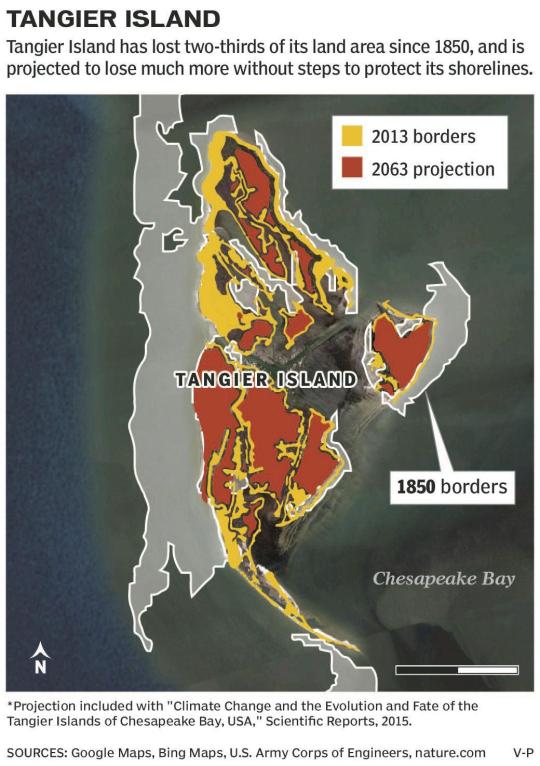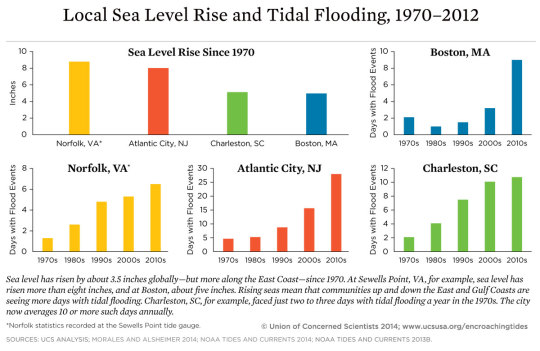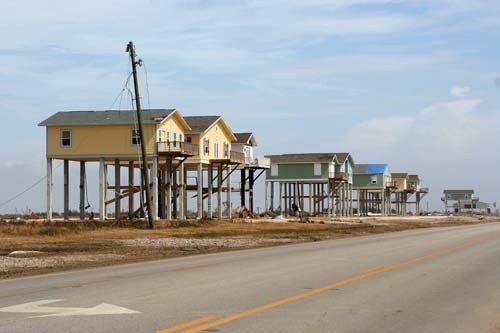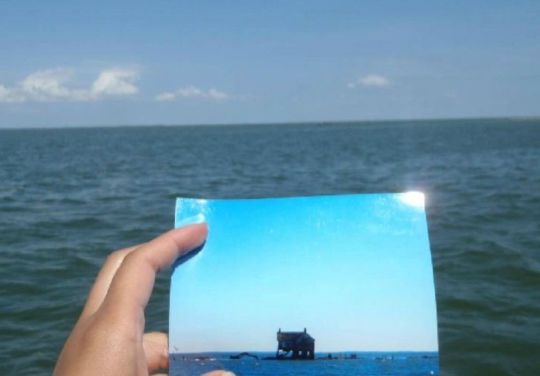Don't wanna be here? Send us removal request.
Text
The Disappearing Islands of the Chesapeake Bay
Many years ago, when I was a child, I remember riding on a boat through the Chesapeake Bay. I leaned against the bow of the old fishing boat and felt the breeze whip through my hair. Far off in the distance I saw an old house, barely standing, surrounded by water with no land in sight. I thought to myself “how did this house get here?” Seeing my puzzled gaze, my uncle explained to me that there was once an island with hundreds of people living on it in that very spot not even a hundred years ago. He drove the boat closer so that I could get a better view. The loud engine of the boat startled a few pelicans away that were nesting on the roof of the house. So many thoughts racing in my mind, but before I could ask another question, he told me “the Bay has taken her back”. From that day I’ve remained intrigued by Holland Island and the old house in the bay. Since then I’ve learned that climate change has played a major role in many of the problems residents in the bay are feeling today. What will they do, and where will they go? Through this research I have learned there are other factors at play, and that most can be combated through updated policies and raising awareness as well as helping to prevent this on a larger scale. Many residents of small coastal and island communities such as Tangier Island, are losing their homes and way of life due to relative sea level rise as a result of Climate change. If we continue to inadequately address these issues and ignore the main problem, we will lose these islands and the Chesapeake Bay will irrevocably bear the scars of our failed attempts and lack of trying. Holland Island is a stark reminder of our failures at combating climate change, and Tangier island gives hope that there is a possibility of saving it from the rising sea, given its dismal future from many scientists. Tangier and Holland islands are a good example of issues that many other countries are facing as well. With the best scientific evidence and more “common sense” policies our government can make more sensible laws to help save the bay and the pockets of the American taxpayer. It’s important for us to understand how responsible Climate change is to the disappearing islands of the Chesapeake Bay and what processes can be adapted to slow the rising sea level globally.
Holland Island was destroyed by climate change and island abandonment.
Holland island was a largely inhabited island that was abandoned due sea level rise as a result of climate change and is an example of the worst-case scenario of Climate change. Holland island was once located in the Chesapeake Bay just west of Salisbury, Maryland. It was settled in the 1600s and boasted a community of over 360 residents, making it one of the largest inhabited islands in the Chesapeake Bay. The islanders made their living on crabbing and fishing the Bay for hundreds of years. The dramatic change in Holland Islands population and land loss has sparked interest and drive in many people who wish to learn from this example. A Physical Scientist, Sheila Gibbons, has spent years conducting studies on the history of Holland Island and the Chesapeake Bay. She has a double major in Geography and has worked with the Strategic Environmental Assessments Division of NOAA for the state of Maryland. In her detailed report published on the rise and fall of Holland Island she concluded the first signs of land loss on the island were documented in the 1850’s and continued into the early 1900’s. (Gibbons, 2011, p. 44). Holland island was roughly five miles long and one and half miles wide when residents began to react to the first serious signs of land loss. In her research she explains that the island was declining in size over the years and forcing residents to move closer inland, or to the main land completely. In 1918 a severe storm struck the island, pushing the community church from its foundation, nearly destroying it. This event was considered the final blow for the last remaining families on the island. The declining size of the island and with the sheer drop in the population, it forced the last remaining residents to make the decision to leave. By 1922 the island was completely abandoned. The island was abandoned in the early 1920’s due to sea level rise and a loss of faith of its people in their future in the island (p. 46). Abandonment is discussed in many scientific descriptions regarding the longevity of islands around the world. It acts as the final accelerator that contributes to the ultimate demise of an island, once the residents lose hope, the island disappears. For Holland island the loss of the community church was the final straw.
Jenna Miller is a multimedia journalist for USA Today and frequently writes on topics involving Climate Change. She published an article on the grim future of the bay saying it is “on the worst-case pathway” (Miller, 2018 p. 1) regarding sea level rise. Holland island is a perfect example of “worst case scenario” because today, nothing remains of the island. The community and its residents that once lived quietly for hundreds of years will all but remain a memory. Efforts were made to preserve the last standing home on the island, but for many years gained little traction. Without adequate financial support and little time to reverse the damage to the island all attempts ultimately failed. In 2003 Hurricane Isabel decimated the last remaining house, and it currently sits dismantled below sea level. This island is an important reminder of what may be to come for several other islands located within the Chesapeake Bay. Without preemptive planning and careful consideration of scientific research, other islands may face abandonment just as Holland Island did.
youtube
An animated ballad, by Lynn Tomlinson, recounts the story of the last house on Holland Island.
What other islands in the Bay are at risk?
There are other islands in the Chesapeake Bay that are threatened by the effects of Climate Change. Just a few miles south from where Holland Island once stood is Tangier Island. It is known for its distinct dialect of American English and its quiet water-man way of life. The island is currently home to roughly 500 people and every resident on that island is currently facing homelessness. Tangier Island is one of the last two inhabited offshore islands in the Chesapeake Bay (Smith Island being the second). David M. Schulte is the managing partner at Chilmark Partners, LLC and he provides reconstruction information for geological land masses and has spent many years studying the complex dynamics that are affecting the island. He conducted an in-depth study on the history of the island and what can be expected for its future. The data he collected shows that Tangier Island has lost most of its landmass since 1850 (Schulte, pg. 4). This data coincides with the time frame of when Holland Island began to lose its shoreline as well. The area that was abandoned was once called the “Uppards” and it was the largest residential portion of the island. It was populated in the early 1900’s. This specific area of the island has been losing 15 feet of shoreline or more each year. Today it is almost entirely submerged with a few remaining headstones from the local graveyard. All the houses and boating docks have since been washed away. The gradual loss of habitable land forced the residents that decided to stay on the island to move more inward to higher ground. Future projections of the island are grim although most residents remain hopeful. Tangier Island has less than 100 years before it is lost to a combination of RSLR (relative sea level rise) and storm surge-induced erosion (p. 4). The Army Corps of Engineers is scheduled to build a levy and a large rock wall to help reduce some of the erosion on one side of the island, however building is not scheduled to start for several years. This gives some of the resident’s hope, but others are cutting their losses and moving to the mainland. The residents fleeing the islands could accelerate the process of abandonment as people lose faith in the future (Gibbons, pg 47). On any given day at high tide major portions of the island become covered in water several inches deep. Water that used to graze homeowners’ properties has now risen to greet them at their front steps. Leaving all who reside on the island with a daily grim reminder that the bay is rising and will only continue to do so. Future projections show the entire Town of Tangier will likely have to be abandoned in less than 50 years due to sea level rise and erosion (p. 6). These projections leave little for the residents of Tangier to cling to. Many hope the construction projects will give them more time in their homes. As the population of their community decreases, the more they worry of becoming the next Holland island and disappearing. Without swift major intervention the residents of Tangier island will become the first documented case of Climate Change refugees in the United States.

A look at Tangier's past – and it's possible future.
How is the Government Getting Involved with Climate Change?
Rising sea levels have caused irreversible damage to the islands as well as placed a heavy financial burden on the American taxpayer. The islands inhabitants have been pushing for more government assistance to slow the effects of sea level rise, but for some residents feel their requests are falling on deaf ears. Annalise Kenney was a Maryland Sea Grant communications intern in summer 2014 and wrote numerous articles for the “Bay Journal”. In one of her articles she discusses the different projects that the residents of the Bay are requesting funding for from government officials, and what responses they are getting in return. To do what is necessary to protect against the effects of sea level rise, there are basically three options. One is armoring: property owners and governments can protect shorelines with hardened structures like stone jetties and seawalls. Another option is adaptation: governments can require that homes be raised, and property owners can do so voluntarily. A third option is retreat: moving away from places that people have called home. (p. 54)
For the islanders in the bay moving away from home is not an option so they have been petitioning their local politicians for years to assist in building up the island and their homes. To preserve their homes and way of life these construction projects are necessary to protect the future of the island. Tangier island has been very vocal in their request for government assistance and projects to include seawalls and jetties to protect what is left of their community. (Kenney, p. 57) A construction project with the Army Corps of Engineers was finally approved in 2018 with plans to create a $2.6 million-dollar jetty. This jetty will protect the inner harbor from further erosion and will reduce the amount of damage the island receives during especially bad storms. The approval for this project took over six years. In hindsight it may not seem long, but with the rapid rate in which the island is losing land mass, every year is crucial to its livelihood.
Pressuring local officials is important to keep the legislative process moving. Because without government intervention the residents have little to no hope to fund the necessary projects to protect the island from further damage. Their greatest battle is fighting the perception that their survival is not worth the effort. Millions of dollars in taxpayer money is needed to protect so few, many politicians feel the money could be better spent. (p. 57) This mindset has been apparent during the jetty project. The issue was originally brought to Congress in 1994, and the Army Corps of Engineers were tasked to study Tangier island to determine the best way to protect the islands harbor. The Army Corp of Engineers concluded in 2009 a jetty would be the more effective and feasible construction for Tangier. There was a long period where nothing moved forward with the project, until finally in 2018 the federal approval process concluded. The approval of the jetty project is good news for Tangier island residents; however, this is only a short-term solution. Gaining governmental support has been difficult for residents of the Bay when they simply wish to preserve and protect their traditional way of life.
Sea levels are rising around the world, although some remain less effected.
Rising sea levels due to Climate Change is not solely affecting the Chesapeake Bay, its financial cost is being felt around the world. Alice Klein is a reporter at New Scientist Magazine and writes about technology, science, space, physics, health and environmental developments. In her article she discusses a study that focused on the islands near Papua New Guinea, the Solomon Islands and Micronesia. The Solomon Islands have been a focus point for scientists because this area is suffering the effects of erosion and sea level rise more quickly than anywhere else in the world. Giving scientists a brief glimpse into the future. Sea levels are currently climbing by an average of 3 millimeters per year around the world due to climate change but is occurring faster in the Pacific Ocean, where a natural trade wind cycle has caused an extra build-up of water over the last half-century. (Klein, p. 1)
youtube
Visual understanding of sea levels around the world.
These changes are a preview for other low-lying nations around the world. The higher than usual sea level from the trade winds has increased the rate at which the islands are eroded. This threat is forcing residents out of their homes much faster than in the Chesapeake Bay. At least eight low-lying islands in the Pacific Ocean have been lost due to sea level rise, with two islands having been lost just in the past 50 years. This research provided scientists with interesting information as to better prepare for rising sea levels. The islands with the trade-wind “bulge” in the Pacific Ocean have eroded more rapidly than islands in other locations. However, some of the islands in the same area have had minimal damage from erosion and in the higher than usual wind. How could one island not far from the other erode and completely disappear, while another remains virtually unaffected? Researchers found that the islands covered in Mangrove trees had the lowest levels of erosion, if any at all. The tree forests broke the severity of the trade-wind and reinforced the sediment of the island, therefore providing a vastly greater level of protection from the elements. The conclusions of this research provide scientists with a more cost-effective method to combating erosion. This information provides researchers with insight to better determine the future of other islands around the world. The best available science is imperative to prevent and protect the remaining coastal areas of the world. Planning for projected sea-level rise increases should be based on credible science, engineering, and economics to ensure careful consideration of cost-effective methods for sustaining the coast. (Williams, p. 55) Planning for sea level rise must be based on the best science available. Researching these islands provided scientists with a greater idea of what is to come for any low-lying area and for other islands around the world. Higher than usual sea levels are financially burdensome for more than just residents on the islands of the Chesapeake Bay.

Future projections for specific east coast cities.
Future planning and lots of science is our best available option at preventing further financial burdens.
Failure to plan for rising sea levels is affecting all low-lying areas in the country would be a costly mistake. A coastal marine geologist, Jeffress Williams discussed future projections of sea level rise and how there are not enough policies that address these issues. He goes into detail about different avenues that can be taken to re-enforce and plan for future erosion because Climate Change is only projected to get worse. He states it is “a global responsibility and will ultimately be more expensive for society if planning isn’t being projected with the best available science”. (Williams, 2015, p. 189). With active planning and building with the future in mind it would help reduce costs in several areas. Raising homes that sit in low-lying areas would prevent damage and reduce costs that accumulate after a significant storm. Many homes in storm/high flood risk areas are more frequently being built on tall pillars that raise the homes enough to save them from high water. As well as building homes farther from the coast to further prevents homes from being damaged. History has shown that Americans and their leaders have tended to react to coastal-flooding disasters rather than prepare for them. Prime examples are shown with the devastation caused from Hurricane Katrina and Sandy. (Kenney, 2013, p. 52) Although the areas hit by these bad hurricanes were not damaged due to climate change or sea level rise directly, it’s important to take notice of how these cities were damaged by the water. Many American cities were built without climate change in mind, thus resulting in incidents such as Hurricane Katrina and the city of New Orleans. Disasters such as these must be kept in mind when building homes and towns in areas near large bodies of water that are susceptible to flooding. As sea levels continue to rise, as its projected to, future planning will become more important in development of coastal communities. Like the Mangrove trees in the Solomon Islands acting as a “buffer” to prevent erosion and slow down winds that further push waves inland and increase erosion. This is a good example of a cost-effective answer to Climate Change induced erosion. As with Tangier island the best option for that island would be the projected building of a levy/jetty which is ultimately a less cost-effective method. All of which provide relief to the immediate areas most effected by erosion and sea level rise. As rising sea levels will continue to be an issue for every coastal city and island across the globe if preventative measures are not put into place in a timely fashion.

Elevated houses on the Bolivar Peninsula in Texas survived Hurricane Ike’s 20-foot storm surge with minimal damage. Homes that were not elevated in this area no longer exist. Image Credit: Greg Henshall/FEMA, Flickr.
The land loss of the islands in the Chesapeake Bay is important to humanity for a multitude of reasons. It is a stark reminder of what could be lost if mankind cannot take better care of its surroundings. The massive amounts of coastal land that has been lost is relative to everyone. It is also an important reminder that planning for Climate Change in the future is something politicians, governments, and everyday people should have more regard for. Every person plays a part in controlling how climate change effects the area in which we live. Holland Island is an example we should strive to never repeat. The inhabitants of Holland Island didn’t have the science of our time and knowledge available to them to save their island. Time was against them, as it currently is for all islands in the Chesapeake Bay as well as every single low-lying area globally. Improving our planning and building with Climate Change in mind we can reduce the speed at which we are losing our coastal communities. Research on the effects of land loss and how it drives inhabitants of islands to abandonment is our best chance at reversing these effects. This research gives hope to the hundreds of people still currently living on Tangier Island who could very possibly lose their homes, but by no fault of their own. The likelihood of abandonment in many coastal communities continues to increase with the rising sea level, as does the cost of maintaining them. Preventative and planning measures and cost-effective building in conjunction with the best available science is the only solution to combating the rising sea level across the globe.

The most current picture of Holland Island and the last remaining home, taken 2017.
References
Arenstam Gibbons, & Nicholls. (2006). Island abandonment and sea-level rise: An historical analog from the Chesapeake Bay, USA. Global Environmental Change, 16(1), 40-47.
S Jeffress Williams, & Nabil Ismail. (2015). Climate Change, Coastal Vulnerability and the Need for Adaptation Alternatives: Planning and Design Examples from Egypt and the USA. Journal of Marine Science and Engineering, 3(3), 591-606.
David M. Schulte, Karin M. Dridge, & Mark H. Hudgins. (2015). Climate Change and the Evolution and Fate of the Tangier Islands of Chesapeake Bay, USA. Scientific Reports, 5(1), 17890.
Cronin, W. (2005) The Disappearing Islands of the Chesapeake. Baltimore, Maryland: The John Hopkins University Press.
Kenney, A. (2013). Come high water. Metropolis, 32(7), 50-83.
Nunn, P.D., Kohler, A. & Kumar, R. J Coast Conserv (2017) 21: 719. https://doi.org/10.1007/s11852-017-0531-7
Subramanian, M. (2018). They Know Seas Are Rising, but They’re Not Abandoning Their Beloved Cape Cod. InsideClimate News. Retrieved 1 May 2019, from https://insideclimatenews.org/news/23102018/cape-cod-sea-level-rise-trump-voters-climate-change-questions-science-based-coastal-building-codes
Draper, H. (2010). ENVIRONMENTAL REVIEWS & CASE STUDIES: Keeping below the Tipping Point: A Literature Review of Climate Change with Attention to NEPA. Environmental Practice, 12(2), 144-157.
Mayfield, D. (2015) Tangier Island Projections. [Photograph by U.S. Army Corps of Engineers.
FEMA - 39260 - Elevetated homes remain stading on the beach in Texas.jpg. (2015, August 20). Wikimedia Commons, the free media repository. Retrieved 20:12, May 1, 2019 from https://commons.wikimedia.org/w/index.php?title=File:FEMA_-_39260_-_Elevetated_homes_remain_stading_on_the_beach_in_Texas.jpg&oldid=169152167.
Tomlinson, L.(2015, March 26). The Ballad of Holland Island House. [Video File] https://www.youtube.com/watch?v=8eKks8-npNs&t=57s
Verge Science. (2018, October 2). Sea level Rise is so Much More Than Melting Ice. [Video File] https://www.youtube.com/watch?v=SA5zh3yG_-0&t=107s
Union of Concerned Scientists. (2014). How Sea Level Rise and Tidal Flooding Threaten US East and Gulf Coast Communities over the Next 30 Years. https://www.ucsusa.org/global_warming/impacts/effects-of-tidal-flooding-and-sea-level-rise-east-coast-gulf-of-mexico
1 note
·
View note